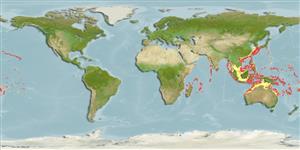Actinopterygii (ray-finned fishes) >
Perciformes (Perch-likes) >
Lutjanidae (Snappers) > Etelinae
Etymology: Etelis: Greek, etelis, -idos = a fish, perhaps the fish Sparus aurata (Ref. 45335). More on author: Cuvier.
Environment / Climate / Range
Ecology
Marine; benthopelagic; depth range 90 - 400 m (Ref. 9821), usually 200 - 350 m (Ref. 82366). Tropical, preferred ?; 34°N - 25°S, 35°E - 150°W (Ref. 55)
Indo-Pacific: East Africa to the Hawaiian Islands, north to southern Japan, south to Australia. Recorded in Three Kings Island, New Zealand (Ref. 35942). This name has been wrongly used for Etelis coruscans by some previous authors.
Length at first maturity / Size / Weight / Age
Maturity: Lm 61.0 range ? - ? cm
Max length : 127 cm FL male/unsexed; (Ref. 2016); common length : 65.0 cm TL male/unsexed; (Ref. 5450); max. reported age: 32 years (Ref. 92312)
Dorsal
spines
(total): 10;
Dorsal
soft rays
(total): 11;
Anal
spines: 3;
Anal
soft rays: 8. Interorbital space flat. Dorsal and anal fins without scales. Scale rows on back parallel with lateral line. Color is mainly pink to red, becoming white on the lower sides and belly.
Adults inhabit rocky bottoms (Ref. 30573). Benthopelagic (Ref. 58302). Feed on fishes and larger invertebrates such as squids, shrimps and crabs; also takes planktonic organisms, including pelagic urochordates. An important food fish in some areas. Marketed fresh or frozen (Ref. 55).
Life cycle and mating behavior
Maturity | Reproduction | Spawning | Eggs | Fecundity | Larvae
Allen, G.R., 1985. FAO Species Catalogue. Vol. 6. Snappers of the world. An annotated and illustrated catalogue of lutjanid species known to date. FAO Fish. Synop. 125(6):208 p. Rome: FAO. (Ref. 55)
IUCN Red List Status (Ref. 115185)
CITES (Ref. 94142)
Not Evaluated
Threat to humans
Harmless
Human uses
Fisheries: highly commercial; gamefish: yes
More information
ReferencesAquacultureAquaculture profileStrainsGeneticsAllele frequenciesHeritabilityDiseasesProcessingMass conversion
Tools
Special reports
Download XML
Internet sources
Estimates of some properties based on models
Phylogenetic diversity index (Ref.
82805): PD
50 = 0.5625 [Uniqueness, from 0.5 = low to 2.0 = high].
Bayesian length-weight: a=0.01585 (0.01285 - 0.01955), b=2.95 (2.89 - 3.01), in cm Total Length, based on LWR estimates for this species (Ref.
93245).
Trophic Level (Ref.
69278): 4.5 ±0.8 se; Based on diet studies.
Resilience (Ref.
69278): Very Low, minimum population doubling time more than 14 years (K=0.07-0.31; tmax=35).
Prior r = 0.24, 2 SD range = 0.07 - 0.77, log(r) = -1.43, SD log(r) = 0.59, Based on: 2 M, 5 K, 1 tmax, records
Vulnerability (Ref.
59153): Moderate vulnerability (44 of 100) .
